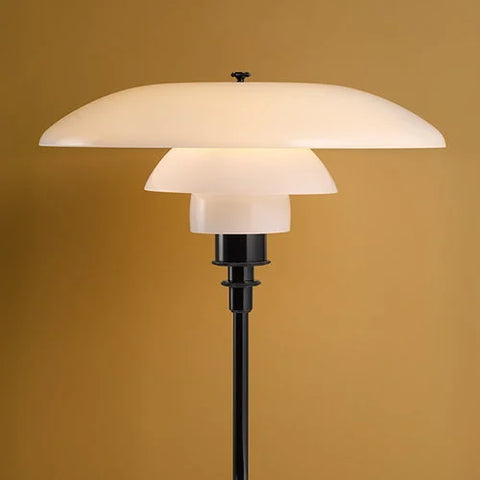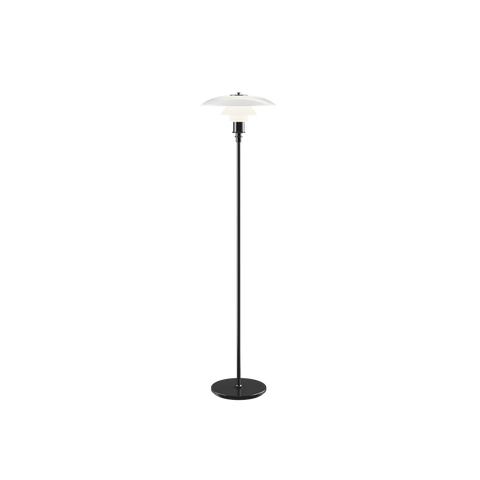






PH 3½-2½ Floor Lamp
The fixture is designed based on the principle of a reflective three-shade system, which directs the majority of the light downwards. The shades are made of handblown opal three-layer glass, which is glossy on top and sandblasted matte on the underside, giving a soft and diffused light distribution.
Poul Henningsen designed the three-shade lighting system in 1925/1926 for an exhibition in Paris, continuing his work with Louis Poulsen until his death in 1967. His goal was to create glare-free lighting that directed light where needed and produced soft shadows using incandescent bulbs.
The 3½-2½ Floor light is one of 19 versions in the three-shade family. Over the years, about a thousand models, including table, floor, and wall lamps, as well as chandeliers, were produced. These lights were popular in the 30s for homes with high ceilings and were available in various colors and sizes. Initially, shades were metal with painted undersurfaces; later, glass was introduced to provide both downward and ambient light.
PH used a scientific approach to lighting, employing the logarithmic spiral for even light distribution and glare control. Each shade reduced light evenly due to its distance from the source. Model numbers correspond to shade sizes, with the 3½-2½ Floor model featuring a 35 cm top shade. This model, introduced in its current form in 2002, allows for lower pendant heights and is used in various lamp types.
This product doesn't have any reviews yet. Be the first to bring iconic design into your home and share your thoughts!
51.2"H x 11.3"Ø Base Plate, Cable Length: 144"
Light Source:
1 x 15W LED A-19/medium E26
Material:
Base: Black metallised or high lustre chrome plated, spun brass
Shades: Hand-blown white opal glass
Top Plate: Black metallised or high lustre chrome plated, spun brass
Stem: Black metallised or high lustre chrome plated, steel
Most Louis Poulsen lighting fixtures come with a 5-year warranty. However, specific products have different coverage:
- Portable fixtures (such as table and floor lamps): 2-year warranty
- Separately purchased components (like replacement parts): 2-year warranty
Established in 1874 as a lighting manufacturer, Louis Poulsen has become one of the world's leading producers of lighting. This success is attributed to collaborations with renowned designers and architects like Arne Jacobsen, Øivind Slaatto, Poul Henningsen, and Verner Panton.



